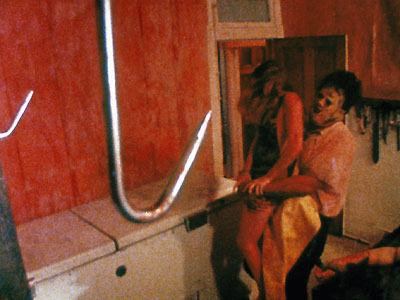some things you have to do. don't mean you gotta like it
Like Psycho, The Texas Chain Saw Massacre begins with a very specific setting—a date on which this “idyllic summer drive turn[s] into a nightmare.” It’s also got an awesome scroll (with narration) to let us know things are going to go very badly—as if the title did not already imply as much. As Sherman Alexie (1992) says in his poem of the same* name, “even its name brings fear.”
* with chainsaw as one word, though, as I tend to think of it as well.
Before I get back to Alexie, I gotta mention the old guy sitting in the tire at the cemetery at the beginning of The Texas Chain Saw Massacre. He seems like the predecessor to all the crazy old guys who warn people away in the various Friday the 13th films and other slasher films. There was a point in my twenties, when I was writing fiction almost daily, that I wanted to write a story implying those guys—and I think they have a name genre studiers use, but I can’t think of what it is—were actually all the same person (or supernatural being, actually), and he kept coming back to warn people to no avail.

But anyway, Sherman Alexie. His poem links makes no use of the title but for the title; instead he links the violence of The Texas Chain Saw Massacre to the 1864 Sand Creek Massacre, in which some 700 Colorado Territory Militia slaughtered somewhere between 70 and 163 Arapaho and Cheyenne, two-thirds of them women and children. “When Leatherface crushes the white boy’s skull,” he writes,
with a sledgehammer, brings it down again and again
while the boy’s arms and legs spasm and kick wildly
against real and imagined enemies, I rememberanother killing floor
in the slaughter yard from earlier in the film,
all the cows with their stunned eyes and mouths
waiting for the sledgehammer with fear so strong
it becomes a smell that won’t allow escape. I rememberthe killing grounds
of Sand Creek... (lines 8-19)
Think of all the violence on display in this and every other slasher film I’ll be watching this month, not to mention numerous other horror films, not to mention action films and adventure films, even some comedies. Classic cartoons are built around violent acts, often without real consequence. We grow up on violence. It’s everywhere.
Really, it’s no wonder that it’s so many of our stories, so many of our films. As Alexie says, “there is nothing surprising / about a dead body” (lines 24-25).
Hell, look at the setup behind this film. Leatherface and his family do what they do partly because there’s just something wrong with them and partly because their jobs at the slaughterhouse—where society would be perfectly fine with them doing the same things to cows—were lost to automation. The violence became mechanized, just as it has in war, just as it becomes in later films like the Saw series. In a way, it no longer qualifies as violence because it is automated. Automated death lacks the energy of violence. The family in this film—they have taken back the violence they were once paid to commit. Like with John Rambo, who 4 years earlier had returned to violence after coming home from war in David Morrell’s novel First Blood (to be a film, itself 6 years after The Texas Chain Saw Massacre), institutionalized violence changes those who are put in a position to commit it.
Alexie writes:
...I have seen it [The Texas Chain Saw Massacre]
and like it: The butchery, its dark humor
that thin line “between art and exploitation,”
because I recognize the need to prove blood
against blood... (lines 28-32)
That thin line between art and exploitation. The slasher film certainly thrives on that line.
Works CitedAlexie, S. (1992). The Texas Chainsaw Massacre. The Kenyon Review 14:3. pp. 45-46..
TCM is one of those films where the true scare comes from the set pieces and the horror of the environment, not from the gore. It also manages to masterfully tease fans with the chainsaw as an instrument of carnage even as it never delivers the gorey usage of it that the title pledges.
ReplyDeleteAlso of note, since you did not mention it, the Ed Gein connection between Psycho and TCM. Gein's crimes were so horrific back in the day, surrogates like Norman Bates and Leatherface had to be created (or in the case of Norman, licensed) to allow film makers to create films about the murders, since the details were too disturbing to get past the censors without changing/omitting details